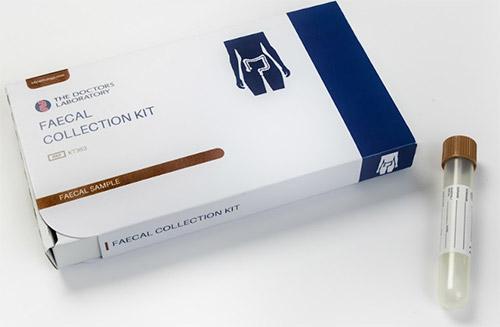What is gut inflammation and how do I test for it?
Medical review by
Dr Alasdair Scott MBBS FRCS PhDKey Article Takeaways
- Inflammation is your body’s immune response to infection or injury.
- Inflammation in the gut can cause bowel symptoms, like diarrhoea, stomach pain and even bleeding.
- Inflammatory bowel disease (IBD) is one cause of long-standing inflammation in the gut.
- Other gut conditions, like irritable bowel syndrome (IBS) can cause symptoms but do not involve inflammation.
- You can test if you have gut inflammation with our Calprotectin Gut Inflammation Test.
Gut symptoms, such as stomach discomfort, cramps and diarrhoea, can really take over your life and often it’s not clear what’s causing them. Sometimes symptoms like these are caused by gut inflammation but often you can have gut symptoms without inflammation. It’s really important to tell the difference because the treatment for each is totally different! We explain what gut inflammation is, what can cause it and how you can test for it.
What is gut inflammation?
Inflammation is your body’s response to injury, infection and other harmful things in your environment. You’ve probably seen your body react to an irritant when your skin is damaged by a scratch or an insect bite. Your skin swells, reddens and feels hot and painful. This is inflammation. This same inflammation process can happen inside your gut too.
Inflammation is your body's natural defence mechanism and is driven by your immune system. It’s essential for you to fight infection and heal. However, sometimes your body can “overreact” and inflammation can go on too long, be too severe or even be directed at the body itself. When this happens in your gut it can damage the lining of the bowel, causing symptoms and even stopping you absorbing nutrients properly.

Are there different levels of gut inflammation?
You might have heard people talk about "gut inflammation" in relation to conditions like obesity and diabetes, or even just the foods we eat. Does that mean our diet or these conditions are causing damage to the cells in our bowel? No, not exactly. You can think of gut inflammation as being on a spectrum, from "low-grade" to "high-grade".
In high-grade inflammation, there is damage to the cells and tissues in the bowel. Your body’s white blood cells (“attack cells”) are attracted to the site of inflammation and they release various substances, many of which act to promote further inflammation. We can actually measure the levels of many of these substances or “inflammatory messengers” so they can make useful tests. You can also see high-grade gut inflammation - it looks similar to what you’d see on your skin but just inside your bowel. The pictures below in figure 1 were taken with a small camera in the bowel and it’s really obvious which one the inflamed bowel is - it just looks “angry”!

This is very different to “low-grade” gut inflammation which you cannot see and is hard to measure. The idea in low-grade inflammation is that the gut cells are not damaged per se but are in an “alert” state, stimulated by substances released from the cells themselves or potentially gut bugs. Unlike high-grade inflammation, these messengers don’t last long in the blood or stool so we can’t pick them up on tests. There’s a lot we don’t understand about low-grade gut inflammation but scientists are interested in the impact it might have on diseases like diabetes and obesity1. Crucially, low-grade inflammation doesn’t damage the bowel, so it’s not thought to be a cause of gut symptoms.
We’ve summarised the difference between low-grade and high-grade inflammation in figure 2.

What can cause gut inflammation?
Gut inflammation can be caused by anything that activates your immune system. Infection with viruses, bacteria or parasites, are a common cause of inflammation that most of us have experienced at one time or another. This “acute” inflammation is usually short-lived as your body clears the infection. We've got a whole article on gut infections and when to test for them.
On the other hand, gut inflammation can also be “chronic”, meaning that it goes on for a long time or keeps coming back. Inflammatory bowel disease (IBD for short) is a common example of a condition that leads to chronic gut inflammation. We’re not 100% sure what causes IBD but it might be related to an overreaction of your immune system to the bugs normally found in your bowel. You might have heard of Crohn’s disease or ulcerative colitis. These are just types of IBD. Crohn’s can affect your whole gut from mouth to anus, whereas ulcerative colitis only affects your colon and rectum.
Who gets inflammatory bowel disease?
Over half a million people in the UK are thought to have IBD2. Safe to say, it's common enough that we all probably know at least one person with some form of IBD.
You can get IBD at any age, but it’s commonly diagnosed between the ages of 17 and 403. One of the biggest things that affects your chance of developing IBD is your family history. Do you have a first-degree relative with IBD, like your parents or siblings? If so, this could increase your chance of developing IBD by up to 10 times4.

Other factors that could make you more likely to get IBD include smoking5 and whether you’ve been on antibiotics in the last 1-2 years6.
What symptoms could gut inflammation give me?
Symptoms that come with gut inflammation are often referred to as “bowel symptoms”. But what actually are they? These can include bloating, diarrhoea, stomach pain or cramps. Needing to use the toilet more often than usual or even noticing blood in your stool can also be signs of inflammation.

Inflammatory bowel disease typically has symptoms which come and go. People experience “flares” where symptoms get worse for a period of time before settling down. This can sometimes make it tricky to realise that something isn’t right as symptoms are not consistent. Over time, damage to the bowel can make it difficult to absorb nutrients properly and you can experience weight loss.
A lot of the symptoms of gut inflammation are similar to another condition you’ve probably heard of called irritable bowel syndrome or IBS.
What’s the difference between IBD and IBS?
IBS is another condition that affects your gut. As we mentioned, IBS can have very similar symptoms to IBD. Let's make sure we don’t get IBS and IBD confused. The “I” in both these acronyms stands for two different things - inflammatory for IBD and irritable for IBS. Inflammatory bowel disease involves inflammation; irritable bowel syndrome doesn’t.
If you had IBS and looked inside your bowel with a camera, you wouldn’t see any inflammation. In fact, your bowel would look normal. This is different to IBD where you would see inflammation and damage to the bowel with a camera test.
The treatments for inflammatory bowel disease and irritable bowel syndrome are very different. IBD usually requires anti-inflammatory medications and sometimes surgery. IBS usually responds well to change in diet and lifestyle.
So how can we tell if you’ve got inflammation or have IBS instead? Fortunately there’s a simple answer. We can do an easy test for gut inflammation.
How can I test for gut inflammation?
The main test for gut inflammation is the calprotectin stool test. Your immune cells release a substance called calprotectin into your gut at the sites of gut inflammation. Calprotectin then eventually ends up in your stool, where we can measure it. Calprotectin is useful as a marker for gut inflammation. In general, the higher the calprotectin level, the greater the inflammation. On the other hand, if your calprotectin is low, you can be pretty confident that there’s no inflammation in your gut. Having raised calprotectin in your stool is recommended by the National Institute for Health and Care Excellence (NICE) as the gold-standard sign of gut inflammation7.
High calprotectin results are often followed up with a colonoscopy. This is a camera test where doctors look inside your bowel to see where the inflammation is and potentially take a tiny sample of gut tissue to diagnose the cause.
Calprotectin is great for distinguishing IBS from gut inflammation. As IBS doesn’t involve gut inflammation, you’ll have a normal or low calprotectin.
Are there other gut inflammation tests?
There are blood tests that detect inflammation in general. The difference is that they’re not specific to your gut.
C-reactive protein (CRP) tests look for CRP, a protein from the liver that shows up early when there's inflammation in your body8. Similarly, a high white cell count can signal inflammation or infection. Both of these blood tests can tell you if you have had inflammation somewhere in your body, but it could be anywhere because the CRP and white blood cells have travelled in your blood.
There are other tests you may come across which will claim to test for gut inflammation. However, faecal calprotectin is currently the only test which is proven and the only one recommended by NICE for use in the UK7.
When should I test myself for gut inflammation?
If you’ve got gut symptoms like bloating, diarrhoea or stomach discomfort that isn’t settling down, you should test for gut inflammation as a possible cause. Before you can safely call it IBS and try changing your diet and/or lifestyle to remedy it, it’s important to rule out an inflammatory bowel condition.

You can take our Calprotectin Gut Inflammation Test to find out if you’ve got gut inflammation or not. This is a simple stool test you take at home and then send to our lab for analysis. If taking a stool test seems new and daunting, we’ve got a whole article on how to do it and it’s easier than you think!
There are other causes of these gut symptoms besides inflammation. One of these potential causes is bowel cancer, so we've created our Easy Gut Inflammation and Bowel Cancer Test to test for both from just one easy sample.
For a wider-coverage panel, our comprehensive Complete Gut Health Test and Symptom Screen tests for coeliac disease, infection and bowel cancer among other major causes of gut symptoms. This test panel uses blood and stool tests and includes the calprotectin gut inflammation test. You can find all the tests you’ll need in one handy package.
What happens if I test positive for gut inflammation?
It’s not quite as simple as testing positive for calprotectin and then definitely having gut inflammation. Your level of calprotectin matters. Table 1 below summarises how to interpret your calprotectin result.
| Calprotectin level (ug/g) | Meaning |
| 0-50 | Normal |
| 50-250 | Borderline. Advised to test again in 2 weeks. If still in this range then treat as “positive”. |
| 250 or above | Positive |
Calprotectin is measured in micrograms per gram of faeces (ug/g). A calprotectin level from 0-50ug/g is normal. This can rule out gut inflammation as a cause of your symptoms and you’re more likely to have IBS.
If your calprotectin levels are 250ug/g or above, you should see a gut doctor (gastroenterologist). You’ll probably need to do a camera test with your doctor to look into what’s causing the inflammation.
A calprotectin level of 50-250ug/g is “borderline” - it’s not high enough to definitely be positive but it’s not completely normal either. In this case, the recommendation is to repeat the calprotectin test in two weeks time. After this, if you’re still above 50ug/g, then you should see a gastroenterologist9. If your calprotectin level has decreased to the 0-50ug/g range, then you’re normal and there’s no need to take action. The reason for this is that some things can cause a brief rise in your calprotectin. For example, a minor gut infection, or even some medicines like aspirin or ibuprofen.
If you take our calprotectin test we’ll give you specific advice on your next steps based on your level. You can also track your results over time which is useful to see if inflammation is responding to treatment.
Get tips on living longer
We're on a journey to becoming the first longevity company and we'd love to bring you along.
Sign up to get our twice monthly Selph Improvement newsletter which is packed with evidence-based tips to optimise your health.
We'll also keep you up-to-date with articles, products and services that are all designed to turn the latest science into more years of better health for you.


